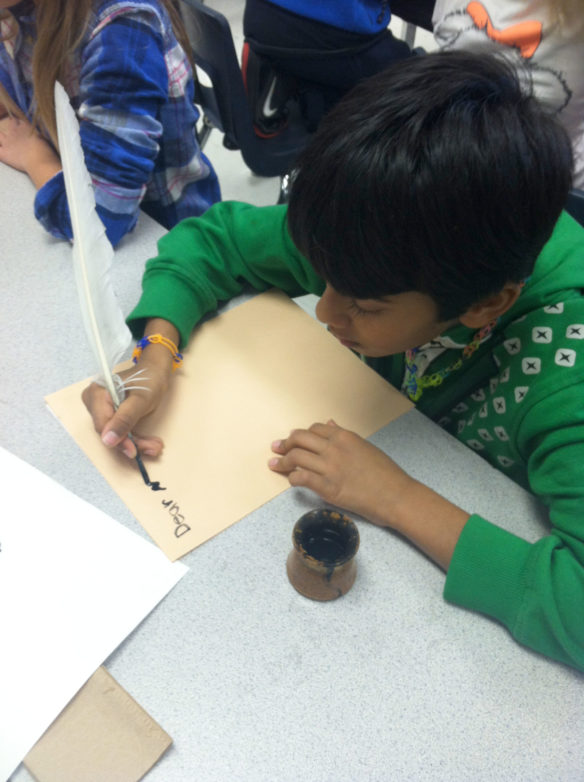
Student at Bridgeport Elementary School (Franklin County) experiment writing with a quill pen and ink as early settlers of Kentucky would have.
Photo by Megan Sauter
By Megan Sauter
Megan.Sauter@ky.gov
The Kentucky Historical Society’s (KHS) outreach program, History smArts, enhances skills in visual and historical literacy among students with the aid of artifact collections.
The program’s development began in August 2013 with a Museums for America grant under the Institute of Museum and Library Services. A curriculum was created that utilizes digital images from KHS’s collections, social studies content themes, arts-related history activities and student assessments.
Each History smArts lesson begins with a Visual Thinking Strategies (VTS) discussion about images presented through paintings, illustrations or photographs. A museum educator asks the students three open-ended questions:
- What’s going on in this picture?
- What do you see that makes you say that?
- What more can you find?
This teaching method allows students to lead the conversation and pull from their background knowledge on the historical subject matter. Students begin to provide evidence for their thoughts and connect ideas to their peers’ responses. Children are continually exposed to visual content through the media, the Internet and other sources, making it imperative that educators teach them how to concentrate and read images.
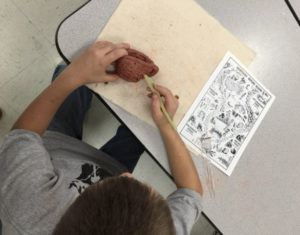
A student at Bridgeport Elementary School (Franklin County) creates a clay pinch-pot in the style of Native Americans.
Photo by Megan Sauter
After the VTS lesson, a museum educator interprets the pictures and introduces an arts activity that aligns with a social studies content theme. Student creations are influenced from learning about Kentucky’s connection with the Civil War, Native Americans, pioneers, inventors, explorers, government, citizenship, economics or geography. Activities include binding journals, molding pinch pots, rolling marbles, designing games, writing with quill pens, building an invention, weaving, spinning wool and object drawing.
During the lesson on Native Americans, for example, students analyze and discuss an image of Woodland Indians that shows a fight between the Native Americans and European settlers and portraits of chiefs painted in connection with treaty signings. They then make a pinch pot, a technique Native Americans used to make some vessels. This dual approach helps students learn how to learn and become familiar with artistic resources that help them learn, rather than just memorizing facts to recite in a classroom or test setting.
KHS piloted each social studies lesson at Bridgeport Elementary School in Franklin County with the 3rd-, 4th- and 5th-grade classrooms during the 2013-14 and 2014-15 school years. All classes were evaluated with pre- and post-program writing assessments intended to determine the program’s effects in building or enhancing students’ skills in visual literacy and analytical writing. The scores suggest that the program is statistically significant in boosting student skills.
Garrett Consulting evaluated the program’s effectiveness. For the writing assessments, students were asked to look closely at an illustration, to describe and interpret what they saw in the picture and to provide evidence for their interpretations. The assignments were graded on a four-point (0-3) rubric, evaluating six domains related to analytical writing skills. Scores ranged from 0-18.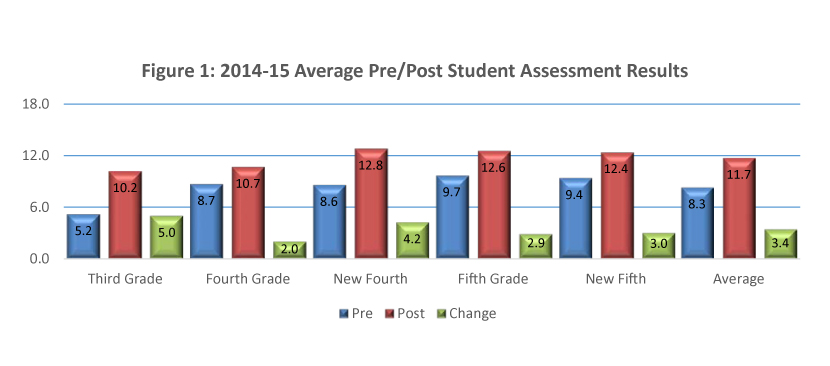
The data in Figure 1 shows the average pre- and post-results for each grade of participating students, as well as the average pre/post change score for each grade. Data from 4th- and 5th-grade students who did not participate in the program during 2013-14 are reported separately. Students in the 3rd grade were new to the program. They had the lowest average post-scores, but the greatest amount of pre/post change over the course of the year.
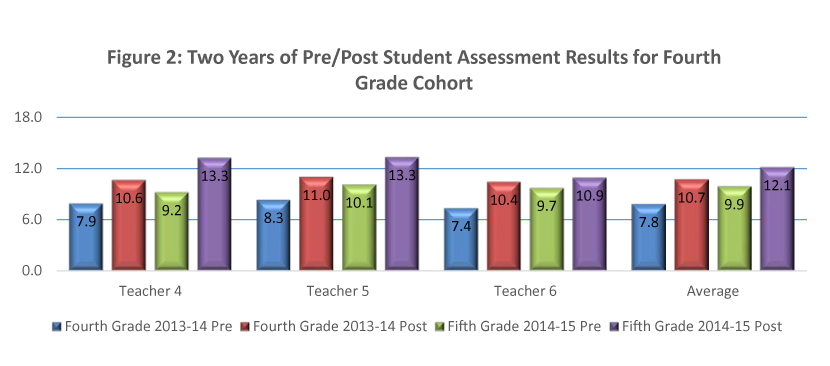 Figure 2 shows data for students who participated in the program during 2013-14 as 4th-graders and again in 2014-15 as 5th-graders. On average, students in all classrooms demonstrated increased proficiency in translating visual literacy skills into analytical writing across the four data points.
Figure 2 shows data for students who participated in the program during 2013-14 as 4th-graders and again in 2014-15 as 5th-graders. On average, students in all classrooms demonstrated increased proficiency in translating visual literacy skills into analytical writing across the four data points.
Bardstown Elementary School (Bardstown Independent) participated in the program for two school years to provide job-embedded professional development for the art teacher and classroom teachers. During the 2014-15 school year, a museum educator implemented each of the 12 lessons as teachers observed. During the 2015-16 school year, a museum educator visited the students during their social studies class to teach the VTS image portion and brought artifacts from the KHS teaching collection. The art teacher followed up the KHS visit with the related arts activity during the enrichment period.
In the past three years, History smArts has grown to reach multiple schools, libraries and community centers across the state. KHS’ mission is to “educate and engage the public through Kentucky history in order to confront the challenges of the future.” History smArts lays the groundwork for children to grow into informed citizens. The project increases student skills in visual literacy, technology, critical thinking, creativity, problem-solving, collaboration and communication – skills they need to meet future challenges in the classroom and in life.
KHS staff collaborate with teachers and district specialists to implement lessons that align with the Kentucky Academic Standards and Program Reviews across disciplines such as social studies, visual art and English/Language Arts. For more information about how to bring the History smArts program to your school, contact Megan Sauter at Megan.Sauter@ky.gov or visit history.ky.gov/history-smarts.
Megan Sauter is the student outreach coordinator at the Kentucky Historical Society.

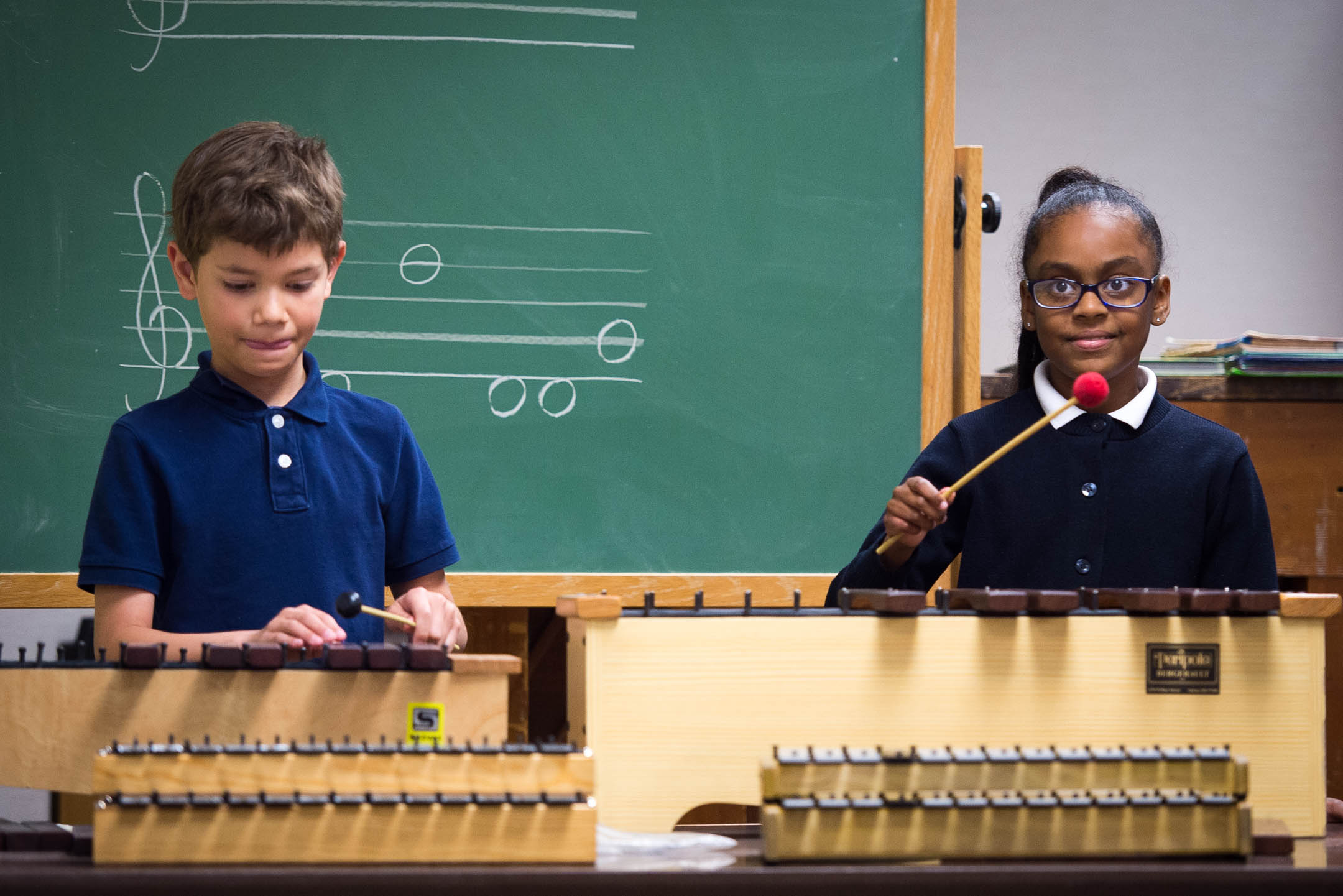

Leave A Comment